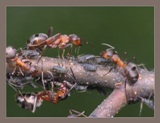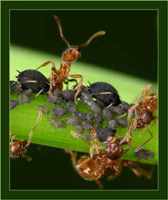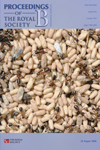|
8. ВЫВОДЫ
Экологические последствия взаимодействий "муравьи-равнокрылые, сосущие соки растений" остаются плохо понятыми, либо из-за игнорирования, либо из-за недостаточной проработки иисследований. Однако, такие взаимодействия имеют потенциально широкие экологические эффекты. Whether because they are assumed, ignored, dismissed or simply overlooked, the ecological consequences of ant–hemipteran interactions and their importance in arthropod communities remain poorly understood. Interactions between ants and honeydew-producing hemipterans are abundant and widespread in arthropod food webs and have potentially broad ecological effects, because the presence of honeydew-producing hemipterans dramatically alters the abundance and predatory behaviour of ants on plants. Future studies should focus on the ecological factors that influence the consequences of ant–hemipteran interactions to provide greater insight into the role of positive species interactions in food web dynamics and greater predictability of the direct and indirect effects of herbivores and natural enemies on host plants. Such predictability could substantially benefit biological control in agricultural systems with ants and honeydew-producing hemipterans. Finally, we encourage a more concerted effort to study the consequences of ant–hemipteran interactions involving invasive ants on arthropod communities and host plants and to make comparisons with native ants.
Инвазивные виды муравьев имеют потенциал, чтобы дать выход экологическому опустошению в средах их нового обитания, которые они захватывают в ходе инвазий; таким образом, понимание последствий их взаимодействий с создающими медвяную росу равнокрылыми может помочь предсказывать и даже управлять их эффектами.

Тли и Formica rufa.
(Фото: П.Корзунович >>>)
ч.1 - Введение,
ч.2 - Методика и Влияние симбиоза "муравьи-равнокрылые" на структуру и разнообразие сообщества,
ч.3 - Влияние симбиоза на растения,
ч.4 - А что получают сами растения? Список 11 факторов,
ч.5 - Влияние инвазивных видов муравьев,
ч.6 - Выводы и литература
ЛИТЕРАТУРА
Bach, C.E. Direct and indirect interactions between ants (Pheidole megacephala), scales (Coccus viridis) and plants (Pluchea indica). Oecologia. 1991;87:233–239.
Banks, C.J; Macaulay, E.D.M. Effects of Aphis fabae Scop. and of its attendant ants and insect predators on yields of field beans (Vicia faba L.). Ann. Appl. Biol. 1967;60:445–453.
Beardsley, J.W, Jr; Su, T.H; McEwen, F.L; Gerling, D. Field investigations of the interrelationships of the big-headed ant, Pheidole megacephala, the gray pineapple mealybug, Dysmicoccus neobrevipes, and the pineapple mealybug wilt disease in Hawai'i, USA. Proc. Hawaiian Entomol. Soc. 1982;24:51–58.
Beattie, A.J. Cambridge University Press; Cambridge, UK: 1985. The evolutionary ecology of ant–plant mutualisms.
Bluthgen, N; Verhaagh, M; Goitia, W; Jaffe, K; Morawetz, W; Barthlott, W. How plants shape the ant community in the Amazonian rainforest canopy: the key role of extrafloral nectaries and homopteran honeydew. Oecologia. 2000;125:229–240.
Bluthgen, N; Stork, N.E; Fiedler, K. Bottom-up control and co-occurrence in complex communities: honeydew and nectar determine a rainforest ant mosaic. Oikos. 2004;106:344–358.
Boucher, D.H; James, S; Keeler, K.H. The ecology of mutualism. Annu. Rev. Ecol. Syst. 1982;13:315–347.
Bradley, G.A. Effect of Formica obscuripes (Hymenoptera: Formicidae) on the predator–prey relationship between Hyperaspis congressis (Coleoptera: Coccinellidae) and Toumeyella numismaticum (Homoptera: Coccidae). Can. Entomol. 1973;105:1113–1118.
Bristow, C.M. Differential benefits from ant attendance to two species of Homoptera on New York ironweed. J. Anim. Ecol. 1984;53:715–726.
Bronstein, J.L. Our current understanding of mutualism. Q. Rev. Biol. 1994a;69:31–51. doi:10.1086/418432
Bronstein, J.L. Conditional outcomes in mutualistic interactions. Trends Ecol. Evol. 1994b;9:214–217.
Buckley, R. Interaction between ants and membracid bugs decreases growth and seed set of a host plant bearing extrafloral nectaries. Oecologia. 1983;58:132–136.
Buckley, R.C. Interactions involving plants, Homoptera, and ants. Annu. Rev. Ecol. Syst. 1987;18:111–135.
Buckley, R.C; Gullan, P.J. More aggressive ant species (Hymenoptera: Formicidae) provide better protection for soft scales and mealybugs (Homoptera: Coccidae, Pseudococcidae). Biotropica. 1991;23:282–286.
Carroll, C.R; Janzen, D.H. Ecology of foraging by ants. Annu. Rev. Ecol. Syst. 1973;4:231–257.
Carter, W. Wiley; New York, NY: 1962. Insects in relation to plant disease.
Compton, S.G; Robertson, H.G. Complex interactions between mutualisms: ants tending homopterans protect fig seeds and pollinators. Ecology. 1988;69:1302–1305.
Compton, S.G; Robertson, H.G. Effects of ant–homopteran systems on fig–fig wasp interactions. In: Huxley C.R, Cutler D.F. , editors. Ant–plant interactions. Oxford University Press; New York, NY: 1991. pp. 120–130.
Cooper, L. B. 2005 The potential effects of red imported fire ants (Solenopsis invicta) on arthropod abundance and Cucumber Mosaic Virus M.Sc. thesis, Auburn University, Auburn, AL, USA.
Crutsinger, G.M; Sanders, N.J. Aphid-tending ants affect secondary users in leaf shelters and rates of herbivory on Salix hookeriana in a coastal dune habitat. Am. Midl. Nat. 2005;154:296–304.
Cushman, J.H. Host-plant mediation of insect mutualisms: variable outcomes in herbivore–ant interactions. Oikos. 1991;61:138–144.
Cushman, J.H; Addicott, J.F. Conditional interactions in ant–plant–herbivore mutualisms. In: Huxley C.R, Cutler D.F. , editors. Ant–plant interactions. Oxford University Press; New York, NY: 1991. pp. 92–103.
Cushman, J.H; Whitham, T.G. Conditional mutualism in a membracid–ant association: temporal, age-specific, and density-dependent effects. Ecology. 1989;70:1040–1047.
Cushman, J.H; Whitham, T.G. Competition mediating the outcome of a mutualism—protective services of ants as a limiting resource for membracids. Am. Nat. 1991;138:851–865.
Davidson, D.W. The role of resource imbalances in the evolutionary ecology of tropical arboreal ants. Biol. J. Linn. Soc. 1997;61:153–181.
Davidson, D.W; Cook, S.C; Snelling, R.R; Chua, T.H. Explaining the abundance of ants in lowland tropical rainforest canopies. Science. 2003;300:969–972.
Dejean, A; Corbara, B. A review of mosaics of dominant ants in rainforests and plantations. In: Basset Y, Novotny V, Miller S.E. , editors. Arthropods of tropical forests: spatio-temporal dynamics and resource use in the canopy. Cambridge University Press; New York, NY: 2003. pp. 341–347.
Dejean, A; Bourgoin, T; Gibernau, M. Ant species that protect figs against other ants: result of territoriality induced by a mutualistic homopteran. Ecoscience. 1997a;4:446–453.
Dejean, A; Djieto-Lordon, C; Durand, J.L. Ant mosaic in oil palm plantations of the southwest province of Cameroon: impact on leaf miner beetle (Coleoptera: Chrysomelidae). J. Econ. Entomol. 1997b;90:1092–1096.
Delabie, J.H.C. Trophobiosis between Formicidae and Hemiptera (Sternorrhyncha and Auchenorrhyncha): an overview. Neotrop. Entomol. 2001;30:501–516.
Del-Claro, K; Oliveira, P.S. Ant–Homoptera interactions in a neotropical savanna: the honeydew-producing treehopper Guayaquila xiphias (Membracidae) and its associated ant fauna on Didymopanax vinosum (Araliaceae). Biotropica. 1999;31:135–144.
Del-Claro, K; Oliveira, P.S. Conditional outcomes in a neotropical treehopper-ant association: temporal and species-specific variation in ant protection and homopteran fecundity. Oecologia. 2000;124:156–165.
Del-Claro, K; Byk, J; Yugue, G.M; Morato, M.G. Conservative benefits in an ant–hemipteran association in the Brazilian tropical savanna. Sociobiology. 2006;47:415–421.
Eubanks, M.D. Estimates of direct and indirect effects of red imported fire ants on biological control in field crops. Biol. Control. 2001;21:35–43.
Eubanks, M. D. & Styrsky, J. D. In press. Ant–hemipteran mutualisms: keystone interactions that alter food web dynamics and influence plant reproduction. In Trophic and guild interactions in biological control (ed. J. Brodeur & G. Boivin), New York, NY: Springer.
Eubanks, M.D; Blackwell, S.A; Parrish, C.J; Delamar, Z.D; Hull-Sanders, H. Intraguild predation of beneficial arthropods by red imported fire ants in cotton. Environ. Entomol. 2002;31:1168–1174.
Fernandes, G.W; Fagundes, M; Greco, M.K.B; Barbeitos, M.S; Santos, J.C. Ants and their effects on an insect herbivore community association with the inflorescences of Byrsonima crassifolia (Linnaeus) H.B.K. (Malpighiaceae). Rev. Bras. Entomol. 2005;49:264–269.
Floate, K.D; Whitham, T.G. Aphid–ant interaction reduces chrysomelid herbivory in a cottonwood hybrid zone. Oecologia. 1994;97:215–221.
Fowler, S.V; MacGarvin, M. The impact of hairy wood ants, Formica lugubris, on the guild structure of herbivorous insects on birch, Betula pubescens. J. Anim. Ecol. 1985;54:847–855.
Fritz, R.S. Ant protection of a host plant's defoliator: consequence of an ant–membracid mutualism. Ecology. 1983;64:789–797.
Holldobler, B; Wilson, E.O. Belknap Press; Cambridge, MA: 1990. The ants.
Holway, D.A; Lach, L; Suarez, A.V; Tsutsui, N.D; Case, T.J. The causes and consequences of ant invasions. Annu. Rev. Ecol. Syst. 2002;33:181–233.
Horvitz, C.C; Schemske, D.W. Effects of ants and an ant-tended herbivore on seed production of a neotropical herb. Ecology. 1984;65:1369–1378.
Ito, F; Higashi, S. An indirect mutualism between oaks and wood ants via aphids. J. Anim. Ecol. 1991;60:463–470.
Jutsum, A.R; Cherrett, J.M; Fisher, M. Interactions between the fauna of citrus trees in Trinidad and the ants Atta cephalotes and Azteca sp. J. Appl. Ecol. 1981;18:187–195.
Kaneko, S. Different impacts of two species of aphid-tending ants with different aggressiveness on the number of emerging adults of the aphid's primary parasitoid and hyperparasitoids. Ecol. Res. 2003;18:199–212.
Kaplan, I; Eubanks, M.D. Disruption of cotton aphid (Homoptera: Aphididae)—natural enemy dynamics by red imported fire ants (Hymenoptera: Formicidae). Environ. Entomol. 2002;31:1175–1183.
Kaplan, I; Eubanks, M.D. Aphids alter the community-wide impact of fire ants. Ecology. 2005;86:1640–1649.
Karhu, K.J. Effects of ant exclusion during outbreaks of a defoliator and a sap-sucker on birch. Ecol. Entomol. 1998;23:185–194.
Kenne, M; Djieto-Loridon, C; Orivel, J; Mony, R; Fabre, A; Dejean, A. Influence of insecticide treatments on ant-Hemiptera associations in tropical plantations. J. Econ. Entomol. 2003;96:251–258.
Khoo, K.C; Ho, C.T. The influence of Dolichoderus thoracicus (Hymenoptera: Formicidae) on losses due to Helopelitis theivora (Heteroptera: Miridae), black pod disease, and mammalian pests in cocoa in Malaysia. Bull. Entomol. Res. 1992;82:485–491.
Lach, L. Invasive ants: unwanted partners in ant–plant interactions? Ann. Mo. Bot. Gard. 2003;90:91–108.
Lohr, B. The pugnacious ant, Anoplolepis custodiens (Hymenoptera: Formicidae), and its beneficial effect on coconut production in Tanzania. Bull. Entomol. Res. 1992;82:213–218.
Mahdi, T; Whittaker, J.B. Do birch trees (Betula pendula) grow better if foraged by wood ants? J. Anim. Ecol. 1993;62:101–116.
Messina, F.J. Plant protection as a consequence of an ant–membracid mutualism: interactions on goldenrod (Solidago sp.). Ecology. 1981;62:1433–1440. doi:10.2307/1941499
Moreira, V.S.S; Del-Claro, K. The outcomes of an ant–treehopper association on Solanum lycocarpum St. Hill: increased membracid fecundity and reduced damage by chewing herbivores. Neotrop. Entomol. 2005;34:881–887.
Moya-Raygoza, G; Nault, L.R. Obligatory mutualism between Dalbulus quinquenotatus (Homoptera: Cicadellidae) and attendant ants. Ann. Entomol. Soc. Am. 2000;93:929–940.
Ness, J.H; Bronstein, J.L. The effects of invasive ants on prospective ant mutualists. Biol. Invasions. 2004;6:445–461.
Nickerson, J.C; Rolph Kay, C.A; Buschman, L.L; Whitcomb, W.H. The presence of Spissistilus festinus as a factor affecting egg predation by ants in soybeans. Fla. Entomol. 1977;60:193–199.
Novgorodova, T.A. Ant–aphid interactions in multispecies ant communities: some ecological and ethological aspects. Eur. J. Entomol. 2005;102:495–501.
Oliveira, P.S; Del-Claro, K. Multitrophic interactions in a neotropical savanna: ant–hemipteran systems, associated insect herbivores and a host plant. In: Burslem D, Pinard M, Hartley S. , editors. Biotic interactions in the Tropics: their role in the maintenance of species diversity. Cambridge University Press; New York, NY: 2005. pp. 414–438.
Perry, J.C; Mondor, E.B; Addicott, J.F. An indirect mutualism: ants deter seed predators from ovipositing in yucca fruit. Can. J. Zool. 2004;82:823–827.
Ragsdale, D.W; Voegtlin, D.J; O'Neil, R.J. Soybean aphid biology in North America. Ann. Entomol. Soc. Am. 2004;97:204–208.
Rapp, G; Salum, M.S. Ant fauna, pest damage and yield in relation to the density of weeds in coconut sites in Zanzibar, Tanzania. J. Appl. Entomol. 1995;119:45–48.
Renault, C.K; Buffa, L.M; Delfino, M.A. An aphid–ant interaction: effects on different trophic levels. Ecol. Res. 2005;20:71–74.
Rico-Gray, V; Castro, G. Effect of an ant–aphid interaction on the reproductive fitness of Paullinia fuscecens (Sapindaceae). Southwest. Nat. 1996;41:434–440.
Rico-Gray, V; Thien, L.B. Ant–mealybug interaction decreases reproductive fitness of Schomburgkia tibicinis (Orchidaceae) in Mexico. J. Trop. Biol. 1989;5:109–112.
Rodriguez-Saona, C; Chalmers, J.A; Raj, S; Thaler, J.S. Induced plant responses to multiple damagers: differential effects of an herbivore and its parasitoid. Oecologia. 2005;143:566–577.
Room, P.M. The fauna of the mistletoe Tapinanthus bangwensis (Engl. & K. Krause) growing on cocoa in Ghana: relationships between fauna and mistletoe. J. Anim. Ecol. 1972;41:611–621.
Rosengren, R; Sundstrom, L. The interaction between red wood ants, Cinara aphids, and pines. A ghost of mutualism past? In: Huxley C.R, Cutler D.F. , editors. Ant–plant interactions. Oxford University Press; New York, NY: 1991. pp. 80–91.
Rosenheim, J.A; Wilhoit, L.R; Goodell, P.B; Grafton-Cardwell, E.E; Leigh, T.F. Plant compensation, natural biological control, and herbivory by Aphis gossypii on pre-reproductive cotton: the anatomy of a non-pest. Entomol. Exp. Appl. 1997;85:45–63.
Sipura, M. Contrasting effects of ants on the herbivory and growth of two willow species. Ecology. 2002;83:2680–2690.
Skinner, G.J. The feeding habits of the wood-ant Formica rufa in limestone woodland in northwest England. J. Anim. Ecol. 1980;49:381–394.
Skinner, G.J; Whittaker, J.B. An experimental investigation of inter-relationships between the wood-ant (Formica rufa) and some tree-canopy herbivores. J. Anim. Ecol. 1981;50:313–326.
Stachowicz, J.J. Mutualism, facilitation, and the structure of ecological communities. BioScience. 2001;51:235–246.
Stadler, B; Dixon, A.F.G. Costs of ant attendance for aphids. J. Anim. Ecol. 1998;67:454–459.
Stadler, B; Dixon, A.F.G. Ecology and evolution of aphid–ant interactions. Annu. Rev. Ecol. Evol. Syst. 2005;36:345–372.
Stechmann, D.-H; Volkl, W; Stary, P. Ant-attendance as a critical factor in the biological control of the banana aphid Pentalonia nigronervosa Coq. (Hom. Aphididae) in Oceania. J. Appl. Entomol. 1996;120:119–123.
Stout, M.J; Workman, K.V; Bostock, R.M; Duffey, S.S. Specificity of induced resistance in the tomato, Lycopersicon esculentum. Oecologia. 1998;113:74–81.
Styrsky, J. D. 2006 Consequences of mutualisms between aphids and an invasive ant to arthropod communities and their host plants. Ph.D. dissertation, Auburn University, Auburn, AL, USA.
Styrsky, J. D. & Eubauks, M. D. In preparation. A facultative mutualism between cotton aphids and an invasive ant indirectly benefits plant reproduction.
Suzuki, N; Ogura, K; Katayama, N. Efficiency of herbivore exclusion by ants attracted to aphids on the vetch Vicia angustifolia L. (Leguminosae). Ecol. Res. 2004;19:275–282.
Tedders, W.L; Reilly, C.C; Wood, B.W; Morrison, R.K; Lofgren, C.S. Behavior of Solenopsis invicta (Hymenoptera: Formicidae) in pecan orchards. Environ. Entomol. 1990;19:44–53.
Van Mele, P; Cuc, N.T.T. Farmers' perceptions and practices in use of Dolichoderus thoracicus (Smith) (Hymenoptera: Formicidae) for biological control of pests of sapodilla. Biol. Control. 2001;20:23–29.
Van Zandt, P.A; Agrawal, A.A. Community-wide impacts of herbivore-induced plant responses in common milkweed Asclepias syriaca. Ecology. 2004;85:2616–2629.
Vrieling, K; Smit, W; van der Meijden, E. Tritrophic interactions between aphids (Aphis jacobaeae Schrank), ant species, Tyria jacobaeae L., and Senecio jacobaea L. lead to maintenance of genetic variation in pyrrolizidine alkaloid concentration. Oecologia. 1991;86:177–182.
Way, M.J. Mutualism between ants and honeydew-producing Homoptera. Annu. Rev. Entomol. 1963;8:307–344.
Way, M.J; Khoo, K.C. Role of ants in pest management. Annu. Rev. Entomol. 1992;37:479–503.
Way, M.J; Paiva, M.R; Cammell, M.E. Natural biological control of the pine processionary moth Thaumetopoea pityocampa (Den & Schiff) by the Argentine ant Linepithema humile (Mayr) in Portugal. Agric. Forest Entomol. 1999;1:27–31.
Wimp, G.M; Whitham, T.G. Biodiversity consequences of predation and host plant hybridization on an aphid–ant mutualism. Ecology. 2001;82:440–452.
Whittaker, J.B. Effects of ants on temperate woodland trees. In: Huxley C.R, Cutler D.F. , editors. Ant–plant interactions. Oxford University Press; New York, NY: 1991. pp. 67–79.
Whittaker, J.B; Warrington, S. An experimental field study of different levels of insect herbivory induced by Formica rufa predation on sycamore (Acer pseudoplatanus). III. Effects on tree growth. J. Appl. Ecol. 1985;22:797–811.
Yao, I; Akimoto, S. Flexibility in the composition and concentration of amino acids in honeydew of the drepanosiphid aphid Tuberculatus quercicola. Ecol. Entomol. 2002;27:745–752.
Yao, I; Shibao, H; Akimoto, S. Costs and benefits of ant attendance to the drepanosiphid aphid Tuberculatus quercicola. Oikos. 2000;89:3–10.
ч.1 - Введение,
ч.2 - Методика и Влияние симбиоза "муравьи-равнокрылые" на структуру и разнообразие сообщества,
ч.3 - Влияние симбиоза на растения,
ч.4 - А что получают сами растения? Список 11 факторов,
ч.5 - Влияние инвазивных видов муравьев,
ч.6 - Выводы и литература

Тли и Мирмики.
(Фото: П.Корзунович >>>)
***
|



